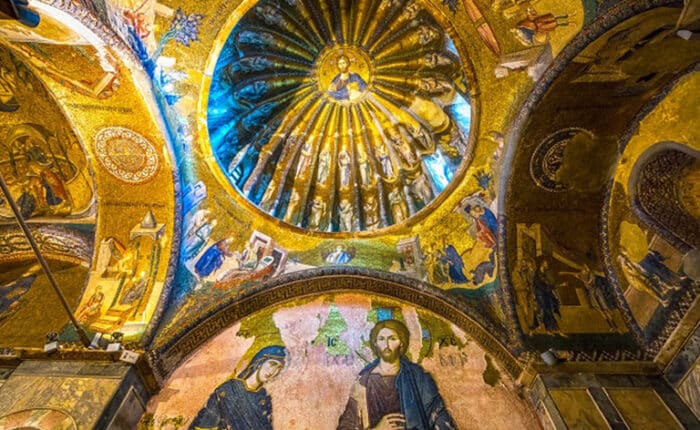Commissioned by the Byzantine Emperor Justinian, the church was initially built in 536 as a monastery over the ruins of the former chapel. Consisting of a dome carried by four columns, it went under several reconstructions enlarged by additions like the Chapel (Parecclesion) on the narrow side. The present church was constructed starting in the 11th century by the mother-in-law of Emperor Elexius I, Maria Doukaina.
Covering a total area of 742 square meters, it is not comparable in size to other Byzantine churches, yet the beauty is inside. So, unlike Hagia Sophia, the importance of Chora is in its incredible mosaics and frescoes, which perfectly matches with the formal yet stylized painting style of the Byzantine era.
It was not only the iconoclastic era in the 8th century when the church suffered some severe damage. Even after the architectural transformation, when restored in the 11th century, another damage was done during the Latin occupation of Istanbul during the Crusades.
Emperor Andronicus II gave this critical task of restoring the construction to the poet Logethete Theodore Metochites who would also make some additions to the building, such as some extra space on the north and an outer narthex to the west. To carry all these additions of the massive landmark, there are round arches, semi-piers, niches, and brickwork of the facades, all serving to keep it lighter.
Following the conquest of Constantinople in 1453, the nave with the beautiful dome was restored, and the building kept serving as a church till 1511. After it was converted into a mosque by Vezir Hadim Ali Pasha, the mosaics and frescoes were whitewashed.
After the restorations and removal of the plaster by the American Institute of Byzantine Studies, it was opened as a museum in 1945. In 2020, it was planned to be converted into a mosque again, but the decision was postponed later on.
The mosaics and frescoes of Chora rank highest among the most beautiful works of Byzantine art in the world and visited by world-famous people such as Queen Elizabeth of Britain, former American president Bill Clinton’s wife Hillary Clinton, their daughter Chelsea and many others.
Some of the paintings in the museum were inspired from the Apocrypha and are not in the Bible. While you can follow the story chronologically, you can see scenes featuring the days before the birth of the Virgin Mary, her mother Anna, her father Joachim, the birth of the Virgin Mary, and her first steps when she was six months old. The characters on the mosaics are so lifelike, and the mosaics were made of as a mixture of stone, metal, glass, tile, and different colors of seashells.
One another important fact about Chora Church is that it is a great visual document for the beginning of the Byzantine Renaissance (the liberation of Byzantine art), where it evolves from the strict dogmas to a more natural approach of the ancient art.
The depiction of above the entrance to the inner narthex featuring Jesus the Pantocrator looks like as if it was made yesterday. When you stand right across the mosaic, it does not look in proportion, but if you move to the left, you will be amazed by the 3D implemented in the Byzantine art.
The outer narthex bears scenes from the life of Jesus and his miracles, such as the three magi, nativity, the healing of the paralytic, and many others. By looking at these depictions, you can quickly see how people were dressed, what accessories they used, in short, fragments of everyday life at the time the church was built.
The most beautiful mosaic is Deisis, depicting Jesus in the middle, Mary on the left with Isaac Comnenus with a nun on the right side of Jesus. The name of the nun is Maria Palaiologina (the daughter of the Byzantine Emperor Michael VIII Palaiologos (1258-1282), who was married to a Mongolian ruler Prince Abaka Khan. Following his death, Maria returned to Istanbul and became a nun.
The next section is the fresco-adorned Parecclesion, of which the depictions preserve its strength despite all the centuries. The stories depicting the afterlife, especially the flying angel carrying a snail (symbolizing the universal), is impressive.
The beautiful veins of the marble revetments in different colors such as white, grey, pink, and yellow, were so professionally paired up that a myriad of figures seems to emerge.
The veins of these marble revetments, which are white, grey, pink, and yellow, have been so ingeniously paired up that a myriad of figures seems to emerge.
“Oh, Mary, I founded this church for you. For you, I named it Chora.
You, who became the instrument for this great miracle that brought life to the dead, a temple for you, Oh immortal God…”



The area is slightly becoming popular and many other travelers are still not aware of the value here.
Try to spare at least one full day as there are many other things to see around.
There are approximately fifty mosaics dating from the 1300s, and most of them are in perfect condition.
Next to the Chora Church, an old house converted to a hotel as part of the conservation carried out in the surroundings of Kariye. The hotel has a restaurant called Asitane that has won a remarkable prestige for its Ottoman Turkish cuisine that you might want to add to your to-do-list while in the area.
Cafes, cake shops, and souvenirs shops have also opened here where you can enjoy a full day by booking a guided tour for Fener & Balat. With its unequaled mystic atmosphere and authentic historical texture, Kariye is one of the places no visitor to Istanbul should miss.